 UPDATED REVIEW – May 5, 2024 – Kawai ES920 Digital Piano | Kawai has a top-of-the-line newer portable digital piano called the ES920 at $1899 internet price. Kawai has had the ES line of portable digital pianos for many years and I have always been impressed by these models. Kawai does things in their portable digital pianos that no other top brand has yet been able to do when it comes to piano playing authenticity and realism,
UPDATED REVIEW – May 5, 2024 – Kawai ES920 Digital Piano | Kawai has a top-of-the-line newer portable digital piano called the ES920 at $1899 internet price. Kawai has had the ES line of portable digital pianos for many years and I have always been impressed by these models. Kawai does things in their portable digital pianos that no other top brand has yet been able to do when it comes to piano playing authenticity and realism,INITIAL THOUGHTS
ES920 KEY ACTION
Let’s go over the ES920 key action in some detail because it is worth talking about. What makes this ES920 key action so special in my opinion is because it is like no other key action in any other portable digital piano under $2000. Kawai calls this key action the “RH3” which stands for “real hammer 3-sensor” key action. I have played this key action many, many times on the prior ES8 and to me this same key action in the new ES920 moves very quickly and yet gracefully which allows a fluid-like key movement that is very responsive whether you are playing aggressive louder fortissimo musical passages or softer, quieter pianissimo passages of music.
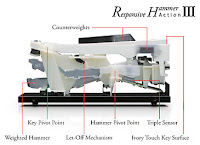 Kawai is still using their proprietary simulated ivory and ebony key-tops which make a great “feel” when playing on the keys.They have a bit of texture but yet are smooth and silky and this material also helps absorbs sweat from the fingers. The simulated ivory and ebony material also looks good on the keys and in my opinion gives it a very classy appearance. This RH3 key action also has counter-weights in the white keys which gives in added weight and balance as the key as are going up & down.
Kawai is still using their proprietary simulated ivory and ebony key-tops which make a great “feel” when playing on the keys.They have a bit of texture but yet are smooth and silky and this material also helps absorbs sweat from the fingers. The simulated ivory and ebony material also looks good on the keys and in my opinion gives it a very classy appearance. This RH3 key action also has counter-weights in the white keys which gives in added weight and balance as the key as are going up & down.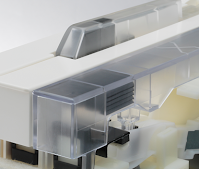 The other key action features of this RH3 action is the 3-sensor electronics for each key which provides for better key repetition sound response along with the “let-off” feature for each key which adds a touch of realism when playing lightly and softly because when pressing down the keys slowly, you will feel a slight notch or hesitation before the key hits bottom.
The other key action features of this RH3 action is the 3-sensor electronics for each key which provides for better key repetition sound response along with the “let-off” feature for each key which adds a touch of realism when playing lightly and softly because when pressing down the keys slowly, you will feel a slight notch or hesitation before the key hits bottom.PIANO SOUND REALISM
 When it comes to the piano sound realism (authenticity) in these higher priced portable digital pianos, it can be a bit subjective as far as what your ears like to hear and the type of sound that will appeal to you. While there are other portable digital pianos out there in this price range with self-contained internal speakers, for my trained (piano) ears I think this newer ES920 has by far the most sophisticated and acoustic piano-like tone that I have ever heard for current model portable digital pianos in this price range under $2000…and I have heard them all up close and personal.
When it comes to the piano sound realism (authenticity) in these higher priced portable digital pianos, it can be a bit subjective as far as what your ears like to hear and the type of sound that will appeal to you. While there are other portable digital pianos out there in this price range with self-contained internal speakers, for my trained (piano) ears I think this newer ES920 has by far the most sophisticated and acoustic piano-like tone that I have ever heard for current model portable digital pianos in this price range under $2000…and I have heard them all up close and personal.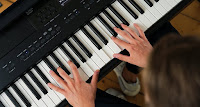 Their commonality is that good acoustic pianos all (obviously) sound like “pianos.” But depending on the type of music you like to play and the way your ears hear it, you will likely prefer on piano over another. With digital pianos I find that some of them sound very artificial and almost synthesized in tone with others sounding twangy and still others having little tonal expression when playing at different velocities.
Their commonality is that good acoustic pianos all (obviously) sound like “pianos.” But depending on the type of music you like to play and the way your ears hear it, you will likely prefer on piano over another. With digital pianos I find that some of them sound very artificial and almost synthesized in tone with others sounding twangy and still others having little tonal expression when playing at different velocities.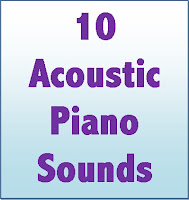 With the ES920, Kawai offers 10 different acoustic piano sound re-creations from different Kawai acoustic grand pianos, upright pianos, and specialty pianos. They have been able to reproduce the piano sound in a way that makes you feel you are playing a “real” grand piano in terms of offering impressive HD piano sound quality and tonal expression with smooth, even dynamics. As compared to the former model ES8, Kawai added 4 additional piano sound tonal elements including undamped string resonance, cabinet resonance, hammer noise, and release time which gives this model more real-time “presence” than it had in the previous model. This allows for musical expression without that artificial flavor I hear in other digital pianos.
With the ES920, Kawai offers 10 different acoustic piano sound re-creations from different Kawai acoustic grand pianos, upright pianos, and specialty pianos. They have been able to reproduce the piano sound in a way that makes you feel you are playing a “real” grand piano in terms of offering impressive HD piano sound quality and tonal expression with smooth, even dynamics. As compared to the former model ES8, Kawai added 4 additional piano sound tonal elements including undamped string resonance, cabinet resonance, hammer noise, and release time which gives this model more real-time “presence” than it had in the previous model. This allows for musical expression without that artificial flavor I hear in other digital pianos.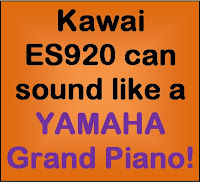 Here’s one more important thing I want to say about the piano sounds in the ES920. Just so you know, I do like playing big acoustic grand pianos and have played hundreds of them professionally over the years including Kawai grand pianos, Yamaha, Steinway, Bosendorfer, Bechstein, Fazioli, and many others. Of those brands one of my favorite grand piano brands to play is Yamaha. Their top of the line acoustic grand pianos have a crisp, clear, and somewhat bright sound to them which is good for jazz, pop, Latin, country, and other types of music where you want brighter, shaper, crisper tones to “cut through.” But Yamaha is not as good for classical music in my opinion and that’s where Kawai grand pianos come in because they have a much more classical tone than Yamaha, more like Steinway and Bosendorfer…and yet Kawai has some great grand pianos for “pop” styles of music as well.
Here’s one more important thing I want to say about the piano sounds in the ES920. Just so you know, I do like playing big acoustic grand pianos and have played hundreds of them professionally over the years including Kawai grand pianos, Yamaha, Steinway, Bosendorfer, Bechstein, Fazioli, and many others. Of those brands one of my favorite grand piano brands to play is Yamaha. Their top of the line acoustic grand pianos have a crisp, clear, and somewhat bright sound to them which is good for jazz, pop, Latin, country, and other types of music where you want brighter, shaper, crisper tones to “cut through.” But Yamaha is not as good for classical music in my opinion and that’s where Kawai grand pianos come in because they have a much more classical tone than Yamaha, more like Steinway and Bosendorfer…and yet Kawai has some great grand pianos for “pop” styles of music as well.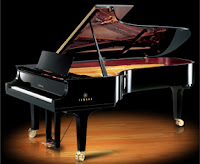 I mention all this because I was able to get the Kawai ES920 to sound very close to a Yamaha grand piano with all those brighter and brassier tonal characteristics that Yamaha is famous for in their grand pianos along with very good bass response. I have played so many different Yamaha acoustic grand pianos over the years that I know them well and the Kawai ES920 has been the only non Yamaha digital piano that I have played which can do a fairly accurate reproduction of the Yamaha grand piano sound. This makes the Kawai ES920 even more versatile for different musical tastes and styles.
I mention all this because I was able to get the Kawai ES920 to sound very close to a Yamaha grand piano with all those brighter and brassier tonal characteristics that Yamaha is famous for in their grand pianos along with very good bass response. I have played so many different Yamaha acoustic grand pianos over the years that I know them well and the Kawai ES920 has been the only non Yamaha digital piano that I have played which can do a fairly accurate reproduction of the Yamaha grand piano sound. This makes the Kawai ES920 even more versatile for different musical tastes and styles.PEDALS
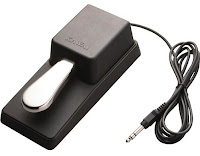 The pedaling on the Kawai ES920 is responsive and smooth and the decay-sustain time when holding down the sustain pedal gives you a lush and full sustained tone and that sustain-decay time is also long in duration and it decays and falls off nicely without being abrupt or lasting too long which would make it sound more artificial. A full size metal single piano style pedal comes with the ES920 and this single pedal also can trigger the “half-damper” effect so that the sustain you hear is variable in length of time it sustains rather than just be on or off like almost all of the other more basic single pedals that come with the other portable digital pianos out there.
The pedaling on the Kawai ES920 is responsive and smooth and the decay-sustain time when holding down the sustain pedal gives you a lush and full sustained tone and that sustain-decay time is also long in duration and it decays and falls off nicely without being abrupt or lasting too long which would make it sound more artificial. A full size metal single piano style pedal comes with the ES920 and this single pedal also can trigger the “half-damper” effect so that the sustain you hear is variable in length of time it sustains rather than just be on or off like almost all of the other more basic single pedals that come with the other portable digital pianos out there.
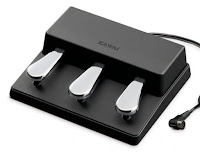 With regard to this single sustain pedal included with the ES920, based on my playing experience with this single pedal, it is by far the best pedal out there in terms of feel, construction, and operation and great for beginners through advanced players. The single pedal included with the piano may not mean much to beginners because they have not played before. But it is important as you progress in your piano playing skills because this pedal will grow with you instead of you needing another type of single pedal. If you prefer a portable pedal unit but need all three pedals which is a good thing to have, Kawai also has an optional portable metal 3-pedal unit called the GFP-3 at $139 which is really good if you are wanting to more easily take it but have access to all pedal functions and more.
With regard to this single sustain pedal included with the ES920, based on my playing experience with this single pedal, it is by far the best pedal out there in terms of feel, construction, and operation and great for beginners through advanced players. The single pedal included with the piano may not mean much to beginners because they have not played before. But it is important as you progress in your piano playing skills because this pedal will grow with you instead of you needing another type of single pedal. If you prefer a portable pedal unit but need all three pedals which is a good thing to have, Kawai also has an optional portable metal 3-pedal unit called the GFP-3 at $139 which is really good if you are wanting to more easily take it but have access to all pedal functions and more. The ES920 also has an optional furniture style triple pedal bar called the F-302 ($169) which attaches to the proprietary furniture stand. I like the triple pedal bar as it easily attaches o the stand which makes it easier to remove if necessary. There is adequate room for the legs and feet to use those pedals. All 3 pedals work well in the furniture option and control the traditional soft, sostenuto, and sustain functions and a couple of other functions. The triple pedal-bar looks nice attached to the stand and allows for more stability of the pedals and permanent placement where the pedals should be located. It also makes the piano and stand look more like a real piano when you have the furniture pedal attachment.
The ES920 also has an optional furniture style triple pedal bar called the F-302 ($169) which attaches to the proprietary furniture stand. I like the triple pedal bar as it easily attaches o the stand which makes it easier to remove if necessary. There is adequate room for the legs and feet to use those pedals. All 3 pedals work well in the furniture option and control the traditional soft, sostenuto, and sustain functions and a couple of other functions. The triple pedal-bar looks nice attached to the stand and allows for more stability of the pedals and permanent placement where the pedals should be located. It also makes the piano and stand look more like a real piano when you have the furniture pedal attachment.INSTRUMENT SOUNDS

When it comes to these portable digital pianos over $1000 I find that most people purchase them primarily to get the best piano playing experience they can get in this price range and the ES920 definitely qualifies for that. However, I find that it is always a bonus if there are also some high quality instrumental sounds like vintage electric pianos, symphony strings and pads, Jazz and pipe organ sounds, harpsichord, and maybe a few synth sounds.
SPECIAL EFFECTS
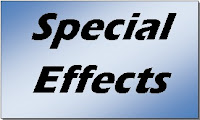 I will say that for a $1899 portable instrument designed to give a person the best piano playing experience under $2000, there sure are many other things you can do with this ES920 that you would not know about just by looking at it. If you just want to use the “preset” factory sound setups and never change them, then that’s great…no problem and you will enjoy your musical experience. But for those of you who are like me and sometimes want to “tweak,” adjust, and modify the factory sounds and setups to your own particular musical tastes, then this piano is also for you. In fact, there are so many ways to to do that on this instrument, it is as they say…mind boggling!
I will say that for a $1899 portable instrument designed to give a person the best piano playing experience under $2000, there sure are many other things you can do with this ES920 that you would not know about just by looking at it. If you just want to use the “preset” factory sound setups and never change them, then that’s great…no problem and you will enjoy your musical experience. But for those of you who are like me and sometimes want to “tweak,” adjust, and modify the factory sounds and setups to your own particular musical tastes, then this piano is also for you. In fact, there are so many ways to to do that on this instrument, it is as they say…mind boggling!VIRTUAL TECHNICIAN
On top of all you can do with the special effects features, Kawai has even included an impressive separate feature for the acoustic piano sounds called “Virtual Technician.” Virtual Technician is where you can go into the editing functions of the piano sounds and adjust the individual organic elements of those sounds which are normally found in real acoustic grand pianos and are natural. However, some people like to minimize or maximize those piano tonal elements because people’s ears (their hearing) is different from one individual to the next and what your ears may like to hear my ears may not want to hear it at all or perhaps not as much…or perhaps even more of it than you would like.
 It’s like how much ketchup, mustard, relish, or onions do you want on that hot dog? Some people want more, some people want less, and some people may not want one or more at all. That is what Virtual Technician is like…it let’s you personally adjust (and it’s easy to do) the string resonances, overtones, sympathetic string vibrations, hammer noise, stretch tuning, individual note volume, and other things that are normally associated with an acoustic piano sound so that you can have more, or less, or none of one or more of them.
It’s like how much ketchup, mustard, relish, or onions do you want on that hot dog? Some people want more, some people want less, and some people may not want one or more at all. That is what Virtual Technician is like…it let’s you personally adjust (and it’s easy to do) the string resonances, overtones, sympathetic string vibrations, hammer noise, stretch tuning, individual note volume, and other things that are normally associated with an acoustic piano sound so that you can have more, or less, or none of one or more of them.4-BAND Graphic EQ
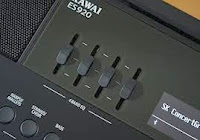 OK…so although you have all of this great stuff you can do to the piano sounds, you would need to go into the user menu to access those features and that can take a bit of time and a slight learning curve as well. However, there is an immediate real-time way of editing and changing the piano sound to give it your own “custom sound setting” and doing it very easily with the all new 4-band graphic EQ system with 4 separate sliders which are located on the control panel surface of the piano. A graphic EQ allows you to instantly change the “frequencies” of the piano sound (or any sound) by adjusting the intensity of those sound frequencies from maximum to minimum.
OK…so although you have all of this great stuff you can do to the piano sounds, you would need to go into the user menu to access those features and that can take a bit of time and a slight learning curve as well. However, there is an immediate real-time way of editing and changing the piano sound to give it your own “custom sound setting” and doing it very easily with the all new 4-band graphic EQ system with 4 separate sliders which are located on the control panel surface of the piano. A graphic EQ allows you to instantly change the “frequencies” of the piano sound (or any sound) by adjusting the intensity of those sound frequencies from maximum to minimum.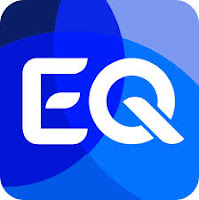 This is a very practical feature because let’s say you are an older person who has lost some hearing ability in the higher frequency range which happens a lot as you get older. Well, you simply boost the high frequency intensity by pushing the high frequency slider up so the sound becomes more clear and sharp. Or perhaps you are a younger person and want more bass in your music…more “thump” as some people refer to it. For that kind of need you would boost the low frequency bass response by pushing up the 1st slider which is the low frequency bass response. You can configure those sliders in any way that you wish to get the sound you want. I love to use the EQ sliders to get the precise sound adjustments for my piano sound depending on the music I am playing.
This is a very practical feature because let’s say you are an older person who has lost some hearing ability in the higher frequency range which happens a lot as you get older. Well, you simply boost the high frequency intensity by pushing the high frequency slider up so the sound becomes more clear and sharp. Or perhaps you are a younger person and want more bass in your music…more “thump” as some people refer to it. For that kind of need you would boost the low frequency bass response by pushing up the 1st slider which is the low frequency bass response. You can configure those sliders in any way that you wish to get the sound you want. I love to use the EQ sliders to get the precise sound adjustments for my piano sound depending on the music I am playing.TRANSPOSE BUTTON
 One of the things some people ask me about that they want in a digital piano is for it to have a dedicated “transpose” feature so that you can modulate (change key) in real time with the press of a physical button as opposed to going into digital menu and trying to find it there. Sometimes when playing in real time in a performance, recital, church, school, etc, you may want to quickly change key in a song and need to use a digital transposer to do that.
One of the things some people ask me about that they want in a digital piano is for it to have a dedicated “transpose” feature so that you can modulate (change key) in real time with the press of a physical button as opposed to going into digital menu and trying to find it there. Sometimes when playing in real time in a performance, recital, church, school, etc, you may want to quickly change key in a song and need to use a digital transposer to do that.ACCOMPANIMENT BACKING TRACKS
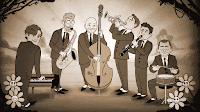 Now it’s time to talk about the “fun features” of the ES920. What I consider to be the “fun stuff” in this piano are the drum rhythms and interactive accompaniment styles. If you will be playing something other than traditional classical music or hymns and you also like playing rhythmic music such as rock, jazz, Latin, country, waltz, big band, blues, gospel, bluegrass, and so on, then Kawai has this super cool feature which I refer to as the backing track accompaniment styles.
Now it’s time to talk about the “fun features” of the ES920. What I consider to be the “fun stuff” in this piano are the drum rhythms and interactive accompaniment styles. If you will be playing something other than traditional classical music or hymns and you also like playing rhythmic music such as rock, jazz, Latin, country, waltz, big band, blues, gospel, bluegrass, and so on, then Kawai has this super cool feature which I refer to as the backing track accompaniment styles.This rhythmic chord system recognizes 15 different chord types including most inversions, diminished, augmented, etc. You simply play full 3 or 4-finger chords on the left hand or even 1-finger chords (which would give you the full chord in just one finger) and turn on your favorite accompaniment style/backing track and you will sound way better than you really are, and just like a real band! Beyond that, this accompaniment system has start & stop, fill-ins, intro, ending, and style variation. You can adjust tempo of your backing tracks and also use this accompaniment feature in a variety of ways.
 You can have a “live” drummer playing drum patterns in 100 different music styles, and you can add a bass player to the drummer, and when you play a left hand chord the bass line will come in within that chord. Then you can add the full instrument band to all of that which then gives you those other instruments (guitar, organ, brass, etc) as I mentioned earlier. Listen to my demo video of this “one-man-band.”
You can have a “live” drummer playing drum patterns in 100 different music styles, and you can add a bass player to the drummer, and when you play a left hand chord the bass line will come in within that chord. Then you can add the full instrument band to all of that which then gives you those other instruments (guitar, organ, brass, etc) as I mentioned earlier. Listen to my demo video of this “one-man-band.”RECORDING FEATURES
 Whether you are a serious piano student, a song writer, or want to learn how to do some multi-track song arranging, having useful recording and playback features in a digital piano can be very helpful and there is no shortage of those features in the ES920.It has 2-track MIDI recording so that you can use that method to record both your right and left hand parts independently and then playing them back independently or simultaneously to hear how you sounded when practicing your music and then to playback both your left and right hand together or independently to analyze how you did by listening to each hand separately and then together.
Whether you are a serious piano student, a song writer, or want to learn how to do some multi-track song arranging, having useful recording and playback features in a digital piano can be very helpful and there is no shortage of those features in the ES920.It has 2-track MIDI recording so that you can use that method to record both your right and left hand parts independently and then playing them back independently or simultaneously to hear how you sounded when practicing your music and then to playback both your left and right hand together or independently to analyze how you did by listening to each hand separately and then together.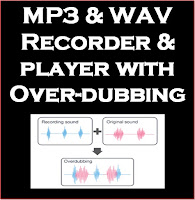 To make it even more fun and more interesting, you can save that completed MIDI song file as a stereo audio MP3 or audio wav file.You can then take that stereo audio file, save it to a USB flash drive and then load it onto your computer or iPad, iPhone, etc and play your completed recorded song on those devices. That’s a pretty cool thing to be able to do because then you can listen your music on any of those devices, let other people hear your music, send your recorded song to anyone you want by attaching it to an email, etc and be able to share it with other people.
To make it even more fun and more interesting, you can save that completed MIDI song file as a stereo audio MP3 or audio wav file.You can then take that stereo audio file, save it to a USB flash drive and then load it onto your computer or iPad, iPhone, etc and play your completed recorded song on those devices. That’s a pretty cool thing to be able to do because then you can listen your music on any of those devices, let other people hear your music, send your recorded song to anyone you want by attaching it to an email, etc and be able to share it with other people.REGISTRATION SETUPS
 For someone like myself, I really enjoy using some of the helpful technology in these digital pianos to make my music even more exciting and enjoyable. I like to create my own personal sound setups such as layering 2 of my favorite sounds together and adjusting relative volume balance, or splitting two of my favorite sounds and assigning a split point and octave change, or setup the accompaniment drums and instruments with a certain rhythmic style and tempo, or maybe I want to transpose the song in a different key for singing or playing purposes, or perhaps “tweak” the piano settings to create my own piano sound the exact way I like it as I have previously mentioned. On some digital pianos once you make those changes and modifications you cannot save it, so all that work you did is gone once to power off the instrument.
For someone like myself, I really enjoy using some of the helpful technology in these digital pianos to make my music even more exciting and enjoyable. I like to create my own personal sound setups such as layering 2 of my favorite sounds together and adjusting relative volume balance, or splitting two of my favorite sounds and assigning a split point and octave change, or setup the accompaniment drums and instruments with a certain rhythmic style and tempo, or maybe I want to transpose the song in a different key for singing or playing purposes, or perhaps “tweak” the piano settings to create my own piano sound the exact way I like it as I have previously mentioned. On some digital pianos once you make those changes and modifications you cannot save it, so all that work you did is gone once to power off the instrument. On the Kawai ES920 there are 28 “memories” to save what are known as “user registrations” that allow you to save up to 28 of your own custom settings and then whenever you want to recall any of them you just touch a couple of buttons on the control panel and it will instantly be reloaded and your piano will be set to play your music just like you had previously set up. Kawai already has including 28 “factory created” setups just to give you a head start in getting some very cool, instant setups from the factory musicians at Kawai. But you can over-write any of them with your own settings although you can always bring back the factory setups with a factory reset to original registrations. I use that registration feature all the time because it saves me a bunch of time and energy to try to reset it all over again.
On the Kawai ES920 there are 28 “memories” to save what are known as “user registrations” that allow you to save up to 28 of your own custom settings and then whenever you want to recall any of them you just touch a couple of buttons on the control panel and it will instantly be reloaded and your piano will be set to play your music just like you had previously set up. Kawai already has including 28 “factory created” setups just to give you a head start in getting some very cool, instant setups from the factory musicians at Kawai. But you can over-write any of them with your own settings although you can always bring back the factory setups with a factory reset to original registrations. I use that registration feature all the time because it saves me a bunch of time and energy to try to reset it all over again.BLUETOOTH WIRELESS
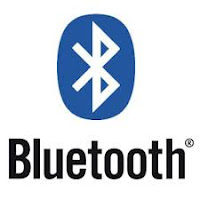 When it comes to wireless connectivity there is a good reason why a lot of people like to have it in their personal devices, especially Bluetooth wireless audio where you can play your music from your mobile phone or tablet through an external Bluetooth speaker. In the world of digital pianos some of the top brands and models have included this type of wireless connectivity in their digital pianos so that you can wirelessly stream your music from your phone, tablet, etc directly through the speaker system in your digital piano.
When it comes to wireless connectivity there is a good reason why a lot of people like to have it in their personal devices, especially Bluetooth wireless audio where you can play your music from your mobile phone or tablet through an external Bluetooth speaker. In the world of digital pianos some of the top brands and models have included this type of wireless connectivity in their digital pianos so that you can wirelessly stream your music from your phone, tablet, etc directly through the speaker system in your digital piano.HEADPHONE SOUND TECHNOLOGY
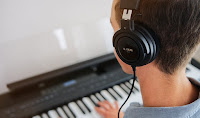 One of the great things about digital pianos is that unlike an acoustic piano, you can practice in complete privacy with a digital pianos because you can plug in stereo headphones.When you plug in wired headphones the internal speaker system is made to shut off and then the sound is only heard through headphones. All digital pianos have this feature so it’s definitely not exclusive to the ES920. However, what the ES920 has that many digital pianos do not have and that the former ES8 also did not have are new headphone listening features that makes it even more enjoyable when using headphones. It’s always important to start off with a good pair of quality stereo headphones which I have used for years and have many different types in my studio.
One of the great things about digital pianos is that unlike an acoustic piano, you can practice in complete privacy with a digital pianos because you can plug in stereo headphones.When you plug in wired headphones the internal speaker system is made to shut off and then the sound is only heard through headphones. All digital pianos have this feature so it’s definitely not exclusive to the ES920. However, what the ES920 has that many digital pianos do not have and that the former ES8 also did not have are new headphone listening features that makes it even more enjoyable when using headphones. It’s always important to start off with a good pair of quality stereo headphones which I have used for years and have many different types in my studio.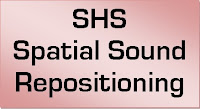 Any pair of stereo headphones will work in this new model but the better the headphones are the better your listening and playing enjoyment will be. Beyond the basics are the new headphone features in this model which includes the new SHS mode to “spatially reposition” the headphone sound that comes in to your ears by digitally moving it forward, keeping it even and centered, or widening the sound so it seems like it is all around you even though the headphones are physically sending the sound directly into your ears. It is newer technology that does this and the result is impressive.
Any pair of stereo headphones will work in this new model but the better the headphones are the better your listening and playing enjoyment will be. Beyond the basics are the new headphone features in this model which includes the new SHS mode to “spatially reposition” the headphone sound that comes in to your ears by digitally moving it forward, keeping it even and centered, or widening the sound so it seems like it is all around you even though the headphones are physically sending the sound directly into your ears. It is newer technology that does this and the result is impressive.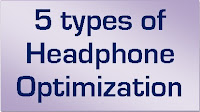 If that weren’t enough when it comes to improving the headphone practice-listening experience, Kawai also has a second new headphone sound feature called “headphone optimization.” What this new feature does is to optimize the headphone sound depending on the type of headphones you are using. For instance, the different headphone designs out there include the following: open, semi-open, closed, inner ear, and canal. Each type of headphone is used for a purpose depending on whether you want your headphones to be completely closed to outside noise, somewhat pen to it, or fully open to it. Canal headphones fit inside the ear cancel and isolate inner sound from the noise outside the ear and also provide for more bass response from those earphones.
If that weren’t enough when it comes to improving the headphone practice-listening experience, Kawai also has a second new headphone sound feature called “headphone optimization.” What this new feature does is to optimize the headphone sound depending on the type of headphones you are using. For instance, the different headphone designs out there include the following: open, semi-open, closed, inner ear, and canal. Each type of headphone is used for a purpose depending on whether you want your headphones to be completely closed to outside noise, somewhat pen to it, or fully open to it. Canal headphones fit inside the ear cancel and isolate inner sound from the noise outside the ear and also provide for more bass response from those earphones.CONNECTIVITY
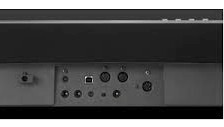 External and internal connectivity in digital pianos can be very important for some people, especially those who want to connect their digital pianos to an external speaker system or they want to use the internal piano speakers to hear their external devices come through the piano speakers. Maybe you want to connect your digital piano from a USB output on the piano to a computer with a USB input so that you can interact with music notation or education software. There are many reasons to want some good connectivity in a digital piano and the ES920 has just about all you would need. It has dual audio output jacks, a stereo line input jack, USB connector, standard MIDI in & out connectors, single damper pedal connector, triple pedal unit connector, a USB flashdrive input connector to load and save songs, and two stereo headphone jacks with one being a standard 1/4″ jack and the other being a 1/8″ mini headphone jack.
External and internal connectivity in digital pianos can be very important for some people, especially those who want to connect their digital pianos to an external speaker system or they want to use the internal piano speakers to hear their external devices come through the piano speakers. Maybe you want to connect your digital piano from a USB output on the piano to a computer with a USB input so that you can interact with music notation or education software. There are many reasons to want some good connectivity in a digital piano and the ES920 has just about all you would need. It has dual audio output jacks, a stereo line input jack, USB connector, standard MIDI in & out connectors, single damper pedal connector, triple pedal unit connector, a USB flashdrive input connector to load and save songs, and two stereo headphone jacks with one being a standard 1/4″ jack and the other being a 1/8″ mini headphone jack.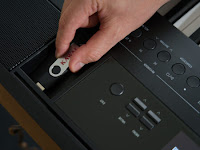 There is also the power supply connector for the included external power supply that comes with the piano. So there is no shortage of connectors and based on my personal experience with Kawai digital pianos, their high quality connector jacks and parts should hold up well over time. Also, for those people with “legacy” MIDI keyboards and sound modules (old technology), those standard “old school” MIDI connectors can come in handy if you happen to have one of those products and want to connect it to the ES920. But generally speaking it is the USB connectivity to external devices that most people use today. Also, if you don’t want to hear the internal speakers of this piano because you are connected to an external system, you can shut off those internal speakers with a small switch on the back of the piano.
There is also the power supply connector for the included external power supply that comes with the piano. So there is no shortage of connectors and based on my personal experience with Kawai digital pianos, their high quality connector jacks and parts should hold up well over time. Also, for those people with “legacy” MIDI keyboards and sound modules (old technology), those standard “old school” MIDI connectors can come in handy if you happen to have one of those products and want to connect it to the ES920. But generally speaking it is the USB connectivity to external devices that most people use today. Also, if you don’t want to hear the internal speakers of this piano because you are connected to an external system, you can shut off those internal speakers with a small switch on the back of the piano.INTERNAL SPEAKER SYSTEM
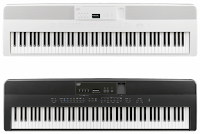 Some portable digital pianos have built-in internal speakers and some portable digital pianos do not have any speakers built in.Those without built-in speakers are typically called “stage digital pianos” because performers on stage in many cases use external stage speakers to hear the sound coming from their piano. The ones with built-in speakers like the ES920 are called “self-contained” digital pianos because you would not necessarily need external speakers to hear the sound. Many of the “self-contained” portable digital pianos under $1000 have low powered internal amplifiers and smaller, more limited speakers.
Some portable digital pianos have built-in internal speakers and some portable digital pianos do not have any speakers built in.Those without built-in speakers are typically called “stage digital pianos” because performers on stage in many cases use external stage speakers to hear the sound coming from their piano. The ones with built-in speakers like the ES920 are called “self-contained” digital pianos because you would not necessarily need external speakers to hear the sound. Many of the “self-contained” portable digital pianos under $1000 have low powered internal amplifiers and smaller, more limited speakers.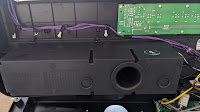 Also, another important aspect of the ES920 speaker system is that the two internal speakers are housed in their own separate enclosures within the body of the piano along with air escapement ports under the piano to help with bass response. You can see this special speaker enclosure with bass air ports in the photo. So the bottom line for this internal sound system is that it is powerful considering the compact portable size of the ES920, and in fact just as powerful as most all of the furniture cabinet digital pianos under $2000.
Also, another important aspect of the ES920 speaker system is that the two internal speakers are housed in their own separate enclosures within the body of the piano along with air escapement ports under the piano to help with bass response. You can see this special speaker enclosure with bass air ports in the photo. So the bottom line for this internal sound system is that it is powerful considering the compact portable size of the ES920, and in fact just as powerful as most all of the furniture cabinet digital pianos under $2000.CONTROL PANEL USER INTERFACE
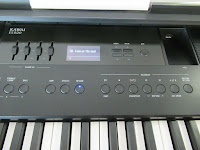 The ES920 has a new updated control panel as compared to the previous model ES8 with 2 areas on the control panel where the buttons, sliders, and display screen is located. The top area has the 4-band EQ sliders and next to that is the new larger and brighter OLED display screen which is much easier to see and read and more intuitive to use. Next to that are the menu control buttons for navigation, etc. Below that area just above the keyboard are the main function buttons of the piano which control pretty much all of the features and functions.
The ES920 has a new updated control panel as compared to the previous model ES8 with 2 areas on the control panel where the buttons, sliders, and display screen is located. The top area has the 4-band EQ sliders and next to that is the new larger and brighter OLED display screen which is much easier to see and read and more intuitive to use. Next to that are the menu control buttons for navigation, etc. Below that area just above the keyboard are the main function buttons of the piano which control pretty much all of the features and functions.PIANO BODY DESIGN
The size, weight, and design of the piano is something that should never be overlooked and the ES920 has some very nice attributes with regard to cabinet design. It has an attractive body design style and a more elegant look to it with rounded edges as compared to the previous model that had straight edges and that is definitely more appealing to the eye.
The fit and finish of the control panel and surface is very nice and the new buttons and sliders have a refined tactile feel to them that gives you the impression you are playing a more expensive instrument than its $1899 price tag would indicate, and even the optional furniture stand and triple pedal bar look great.
PIANO MUSIC RACK
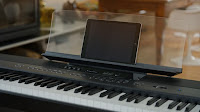 I wanted to point out what otherwise appears to be a relatively small change in this model to some people but is actually a huge upgrade to people who will appreciate it (like me) and it is the newly resigned music rack which comes with this piano. When you want a place to put your sheet music or books on the piano, you have to use the music rack. Actual “stage pianos” typically don’t come with music racks and many of these “self-contained” portable digital pianos have music racks that are poorly designed or cheaply made while others are just ok. The previous Kawai ES8 had a smaller basic wire/metal open music rack that came with it which was OK but not great and it did not allow for complete support of your sheet music or books.
I wanted to point out what otherwise appears to be a relatively small change in this model to some people but is actually a huge upgrade to people who will appreciate it (like me) and it is the newly resigned music rack which comes with this piano. When you want a place to put your sheet music or books on the piano, you have to use the music rack. Actual “stage pianos” typically don’t come with music racks and many of these “self-contained” portable digital pianos have music racks that are poorly designed or cheaply made while others are just ok. The previous Kawai ES8 had a smaller basic wire/metal open music rack that came with it which was OK but not great and it did not allow for complete support of your sheet music or books.FINAL THOUGHTS
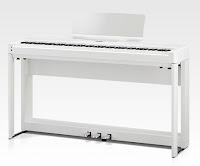 At the end of the day there’s a lot to like about this new Kawai ES920 and very little if anything no not like. All the improvements made to this model as compared to the previous model ES8 pretty much was “on point.” Kawai did not need to change the main piano playing components that were in the prior model because they were already very good and everyone really seemed to love them (as I did) so those three things stayed pretty much the same, but with a few changes. It was all the other things I previously mentioned that changed in this new model including the control panel interface, many new useful features and functions, the improved internal speaker system, cabinet design and layout, and the fact this ES920 is so much lighter to carry or move than the previous model, but yet it is still sturdy and robust.
At the end of the day there’s a lot to like about this new Kawai ES920 and very little if anything no not like. All the improvements made to this model as compared to the previous model ES8 pretty much was “on point.” Kawai did not need to change the main piano playing components that were in the prior model because they were already very good and everyone really seemed to love them (as I did) so those three things stayed pretty much the same, but with a few changes. It was all the other things I previously mentioned that changed in this new model including the control panel interface, many new useful features and functions, the improved internal speaker system, cabinet design and layout, and the fact this ES920 is so much lighter to carry or move than the previous model, but yet it is still sturdy and robust.Oh…and another big thing…all of this improvement should have made the price on the ES920 go “up” from the previous model a few years ago, but yet the price actually came down a bit to $1899 on the ES920. As far as I am concerned, purchasing this model should be a “no-brainer” if you want one of the best piano playing experiences you can get in a more portable self-contained digital piano at any price, even under $3000. I have played them all in this price range including Yamaha, Roland, Casio, Korg, and others and this ES920 beats all of them in my opinion (with maybe the exception of the Casio PX-S6000 at $1799 with regard to the piano playing realism experience in a portable digital piano.
If you want more info on new digital pianos and LOWER PRICES than internet discounts, please email me at tim@azpianowholesale.com or call direct at 602-571-1864.








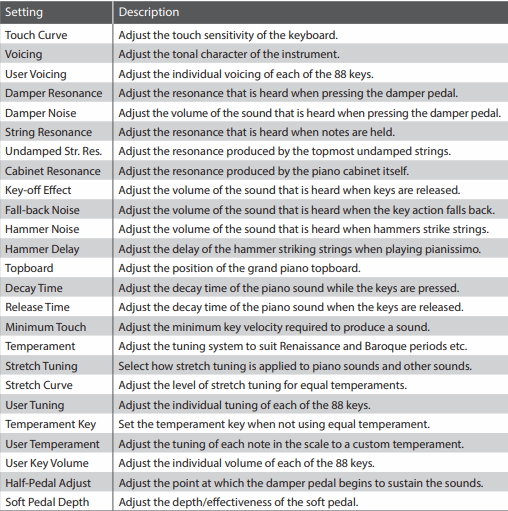
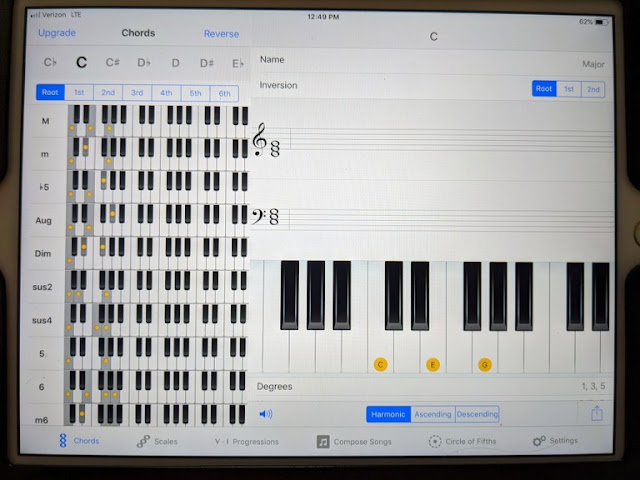
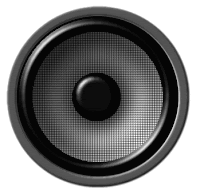
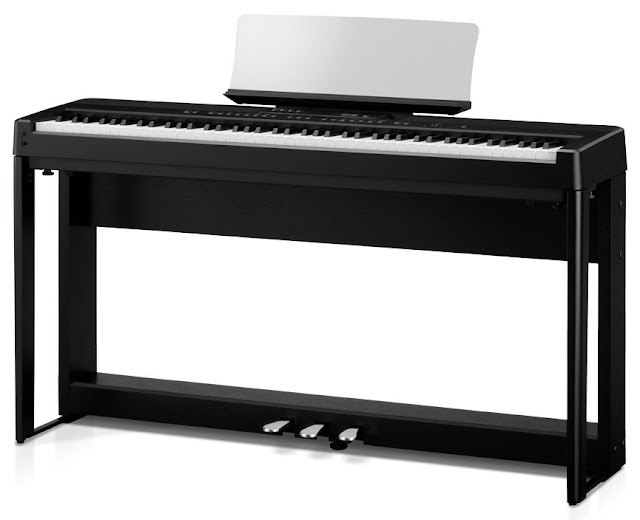
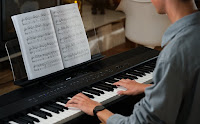
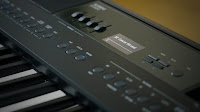
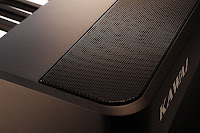











Really excellent review, it's nice to have a written review to refer to at any stage. Seems very unbiased. When I am ready to buy an ES920 white I will contact you further for price and delivery.
Thank you.
Philip Vinton
Hi Tim,
Thanks for your detailed and insightful review.
I have watched a number of YouTube videos where the sound is excellent and the key action is described as amazing.
However, I noticed that the 920 is about 12lbs lighter than the E8. Additionally, it seems to have more of a plasticky exterior appearance than the E8 which appears more metallic. I just wonder if the build quality compared to the E8 would be less given my observations. That would also account for the reduction in price as well.
What are your thoughts about this.
Again, thank you for your time and atttention.
Steven
Thank you for the excellent review! I've ordered an ES920 from you and eagerly await the day when I'll get my fingers on it.
Thanks for the terrific review. I plan to try out the unit once I feel OK about entering music stores in light of the pandemic. One question, though: Is there even better sound to be found for about the same money (or maybe a little more) when combining a slab that doesn't have built-in speakers to good external monitors? Or do you think the ES920 combines the best of both worlds?
I have owned a Kawai ES8 since April of 2016 . Having played the piano for the best part of 65 years , I am
very impressed and satisfied with my ES8 . I have had the opportunity to sample a ES920 at my local music store
and greatly appreciate the fact that Kawai has increased the onboard speaker power . What would concern me is
the thin plastic body of the newer ES920 , compared to the heavier built ES8 . I suppose " time will tell " .
Love your reviews. Great. What nobody seems to have realised is that the Kawai APP also works with the ES920. Meaning that your phone (or tablet) becomes a really easy place to store your settings, registrations, and, in particular, fiddle with the virtual technician. It's there (built in) to the much more expensive CA79, but to have that touch screen option on this much cheaper model I think is great. I downloaded the app now – there's even a demo mode, so I can experiment with it while I'm waiting for my ES920!
Hello all,
Does somebody has an ES920 already and have some experience with it? I ask this because I'm in doubt whether I'm going to buy the ES920 or the Roland FP90x.
I'm a acoustic pianist and in my ears the piano sounds in the ES920 are more natural than in the FP90x, they are more to my liking and inspire me. I know that this is a matter of taste. BUT, yeah, the Roland has the best build quality of both, the plasticky exterior of the ES920 doesn't look so sturdy.
The "bells and whistles" of the ES920 are more than enough for me and I like how I can play on it. At home I have an upright Yamaha, and I need a digital piano for rehearsals and gigs with my jazz combo. So in total I'm on the road with it maybe 4 times a month.
I would be glad to hear your thougths about this.
Jelle (from the Netherlands)
Can you turn off the bluetooth feature?
yes, the Bluetooth feature can be turned off
Jelle, this is a late reply to your questions but I have not be able to reply back until now. You use the word "plasticky" like having plastic on a product is a terrible thing. There are thousands of consumer products out there that are built with very high quality, durable but yet lightweight plastics that never have issues. As long as you protect your piano with a good carry case then all should be fine. I have yet to have anyone report to me that the ES920 cabinet has caused them any issues in terms of structure or durability. The Roland FP90X is 52 lbs of weight whereas the ES920 is 37.5 lbs of weight which allows most people to carry it much more easily. If you are afraid of high quality plastic and reduced weight in the ES920 then buy the Roland. Also, why would a famous and competent piano company like Kawai build an inferior quality digital piano and deal with potential issues because of inferior materials? A company like Kawai would never want to do that plus they have a comprehensive 3 year warranty on it. The ES920 should last for many, many years without problems.
Wow! Best most thorough review I have seen on the ES920. I have been considering the Yamaha DGX-670 because of the fun factor, but after reading your review I am reconsidering. Aspects that that struck home are the quality of the key action, the Onkyo sound system and what you said about adjusting the sound to compare to a Yamaha. However, need to wait until my Petrof IV sells. Not much interest for it on eBay
Is your "secret sauce" concerning the Yamaha grand sound on a es920 a 1st April fool thing?
After two years with the ES920, I am very happy indeed. I find my playing is much better and smoother, which I attribute to the excellence of the action. My fingers seem to find the right notes more easily, and I know the keys are the same distance apart as on other pianos. I've recorded some, but I have yet to really play with all the many features. I love the sound, and it's been great for jazz, classical, ragtime, and pop. It's an amazing value, and I am sure I'll be enjoying this piano for years to come.
Next project: modifying an 1880's upright piano case (which used to house my 1985 Clavinova, after removing the original harp and keys which were in bad shape) to be able to slide the ES920 in and out.
Thanks once again for your advice and reviews, Tim!
Hey, does the keyboard or the optional wooden stand come with a headphone hook/holder?
Thanks for the great review.
No, the stand does not have headphone holder. The stands for portable digital pianos typically do not have that accessory.
What a great comprehensive review. I just ordered a white one.